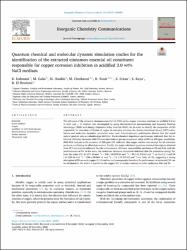| dc.contributor.author | Dahmani, K. | |
| dc.contributor.author | Galai, M. | |
| dc.contributor.author | Ouakki, M. | |
| dc.contributor.author | Cherkaoui M. | |
| dc.contributor.author | Touir, R. | |
| dc.contributor.author | Erkan, Sultan | |
| dc.contributor.author | Kaya, Savaş | |
| dc.contributor.author | El Ibrahimi, B. | |
| dc.date.accessioned | 2022-05-13T11:41:38Z | |
| dc.date.available | 2022-05-13T11:41:38Z | |
| dc.date.issued | Şubat 2021 | tr |
| dc.identifier.citation | K.DahmaniaM.GalaibM.OuakkiaM.CherkaouiacR.TouirbdS.ErkaneS.KayafB.El Ibrahimig
a
Organic Chemistry, Catalysis and Environment Laboratory, Faculty of Science, Ibn Tofail University, Kenitra, Morocco
b
Advanced Materials and Process Engineering Laboratory, Faculty of Science, Ibn Tofail University, Kenitra, Morocco
c
National Higher School of Chemistry (NHSC), University Ibn Tofail BP. 133-14000, Kenitra, Morocco
d
Regional Center for Education and Training Professions (CRMEF), Kenitra, Morocco
e
Chemistry and Chemical Processing Technologies, Sivas Cumhuriyet University, Yıldızeli Vocational School Sivas, Turkey
f
Sivas Cumhuriyet University, Health Services Vocational School, Department of Pharmacy, 58140 Sivas, Turkey
g
Team of Physical Chemistry and Environment, Faculty of Science, Ibn Zohr University, Agadir, Morocco | tr |
| dc.identifier.uri | https://www.sciencedirect.com/science/article/pii/S1387700320309990 | |
| dc.identifier.uri | https://hdl.handle.net/20.500.12418/13058 | |
| dc.description.abstract | The influence of the extracted cinnamon essential oil (CiO) on the copper corrosion resistance in acidified 3.0 wt% NaCl (pH = 2) medium was investigated by using electrochemical measurements and Scanning Electron Microscopy (SEM) with Energy Dispersive X-Ray Analysis (EDS). So, in order to identify the component of CiO responsible for corrosion inhibition of copper in corrosive solution, the density functional theory (DFT) calculations and molecular dynamics simulation were used. Potentiodynamic polarization showed that the tested natural product acts as cathodic-type inhibitor. Electrochemical impedance spectroscopy indicated that the inhibition efficiency increases with CiO concentrations to get up a maximum value of 89% at 200 ppm. In addition, SEM/EDS analysis in the presence of 200 ppm CiO indicated that copper surface was exempt for all corrosion products, confirming its offered protection. Finally, the major calculated quantum chemical descriptors obtained from DFT calculations indicated that the anticorrosion efficiency responsibility attributes to P8 and P46, with the predominance of P8. In the same, the molecular dynamics simulation indicated that the adsorption energy follows the order: P5 (-61.071 kJ mol−1) > P46 (-58.070 kJ mol−1) > P8 (-42.938 kJ mol−1) on Cu (1 1 1) and P8 (-21.220 kJ mol−1) > P46 (-20.066 kJ mol−1) > P5 (-19.591 kJ mol−1) on CuO2 (1 1 0), suggesting a strong adsorption of P8 on oxide copper (1 1 0) surface and consequently therefore the performance of extracted CiO can be attributed to P8, which is parallel to the copper (1 1 1) surface contrary to other molecules P46 and P5. | tr |
| dc.description.abstract | The influence of the extracted cinnamon essential oil (CiO) on the copper corrosion resistance in acidified 3.0 wt% NaCl (pH = 2) medium was investigated by using electrochemical measurements and Scanning Electron Microscopy (SEM) with Energy Dispersive X-Ray Analysis (EDS). So, in order to identify the component of CiO responsible for corrosion inhibition of copper in corrosive solution, the density functional theory (DFT) calculations and molecular dynamics simulation were used. Potentiodynamic polarization showed that the tested natural product acts as cathodic-type inhibitor. Electrochemical impedance spectroscopy indicated that the inhibition efficiency increases with CiO concentrations to get up a maximum value of 89% at 200 ppm. In addition, SEM/EDS analysis in the presence of 200 ppm CiO indicated that copper surface was exempt for all corrosion products, confirming its offered protection. Finally, the major calculated quantum chemical descriptors obtained from DFT calculations indicated that the anticorrosion efficiency responsibility attributes to P8 and P46, with the predominance of P8. In the same, the molecular dynamics simulation indicated that the adsorption energy follows the order: P5 (-61.071 kJ mol−1) > P46 (-58.070 kJ mol−1) > P8 (-42.938 kJ mol−1) on Cu (1 1 1) and P8 (-21.220 kJ mol−1) > P46 (-20.066 kJ mol−1) > P5 (-19.591 kJ mol−1) on CuO2 (1 1 0), suggesting a strong adsorption of P8 on oxide copper (1 1 0) surface and consequently therefore the performance of extracted CiO can be attributed to P8, which is parallel to the copper (1 1 1) surface contrary to other molecules P46 and P5. | tr |
| dc.language.iso | eng | tr |
| dc.publisher | Elsevier | tr |
| dc.relation.isversionof | 10.1016/j.inoche.2020.108409 | tr |
| dc.rights | info:eu-repo/semantics/openAccess | tr |
| dc.subject | Green inhibitorCopperAcidified 3.0 wt% NaCl solutionElectrochemical measurementsSurface analysisTheoretical study | tr |
| dc.subject | Green inhibitor Copper Acidified 3.0 wt% NaCl solution Electrochemical measurements Surface analysis Theoretical study | tr |
| dc.title | Quantum chemical and molecular dynamic simulation studies for the identification of the extracted cinnamon essential oil constituent responsible for copper corrosion inhibition in acidified 3.0 wt% NaCl medium | tr |
| dc.type | article | tr |
| dc.relation.journal | Inorganic Chemistry Communications | tr |
| dc.contributor.department | Fen Fakültesi | tr |
| dc.contributor.authorID | 0000-0001-6744-929X | tr |
| dc.identifier.volume | 124 | tr |
| dc.identifier.endpage | 108423 | tr |
| dc.identifier.startpage | 108409 | tr |
| dc.relation.publicationcategory | Uluslararası Editör Denetimli Dergide Makale - Başka Kurum Yazarı | tr |
















